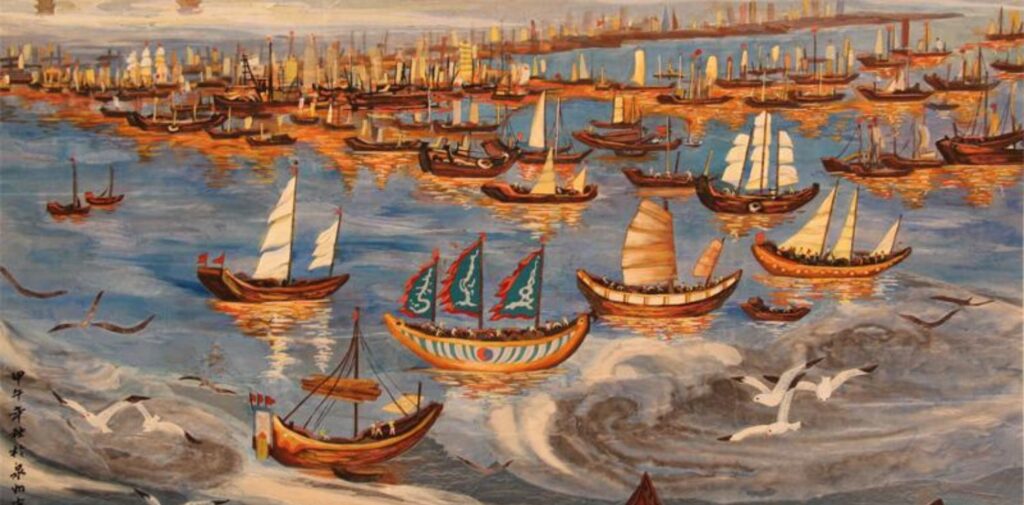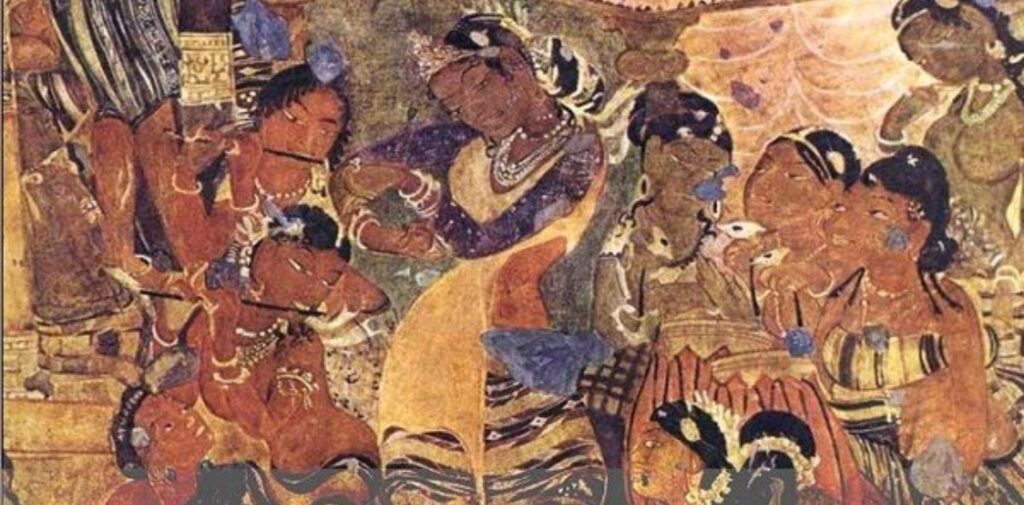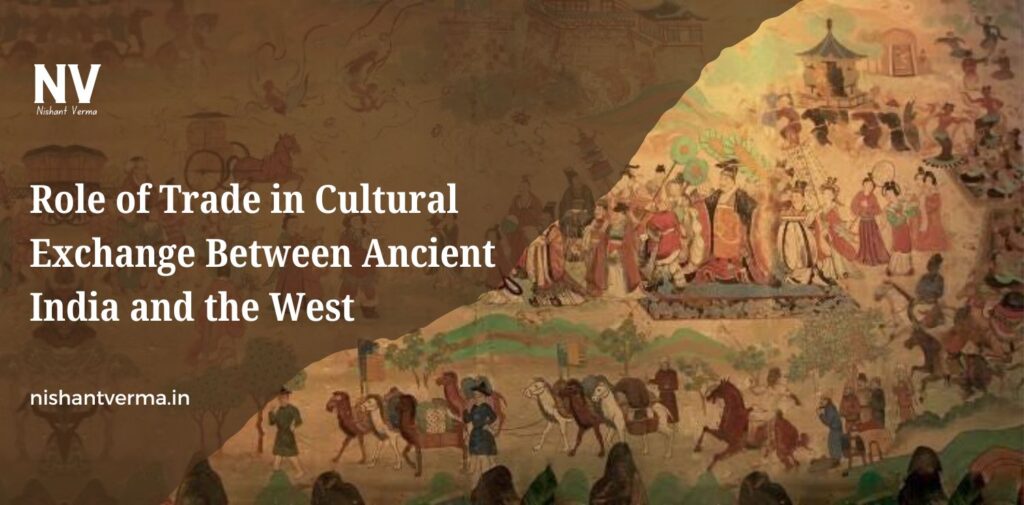Trade has always played a significant role in the development of civilizations throughout history. In ancient times, India was a key player in global trade, connecting the East to the West. Through this exchange of goods, ideas, and knowledge, ancient India contributed significantly to the cultural and intellectual development of the Western world. This article explores the Role of Trade in Cultural Exchange Between Ancient India and the West, shaping art, religion, philosophy, and science.
Early Roots of Trade Between India and the West
The history of trade between India and the West dates back to ancient times, long before the rise of powerful empires or the creation of modern trade routes. Early trade between India and the West began with the exchange of luxury goods like spices, silk, and precious stones. India’s strategic location between the East and West made it a central hub for international trade. Merchants and traders from various parts of the world traveled through India to reach distant lands, creating opportunities for cultural exchanges.
India’s ports on the west coast, such as those in Gujarat and the Malabar Coast, were known for their bustling markets and vibrant trade routes. From there, goods were transported to the Roman Empire, Persia, and beyond. The spread of ideas, art, and technology occurred hand in hand with the exchange of goods.

The Role of the Silk Road and Maritime Routes
Two major trade routes facilitated the flow of goods and culture between ancient India and the West: the Silk Road and maritime routes across the Indian Ocean.
The Silk Road
The famous Silk Road, a network of trade routes that connected China, Central Asia, India, and the Mediterranean, played a vital role in linking India with the West. Indian merchants and traders were active participants in these trade exchanges, which allowed the flow of silk, spices, and textiles to the West. In return, the West sent gold, silver, and glassware to India.
India’s location along the Silk Road also meant that it was a crossroads for the exchange of ideas, religious beliefs, and philosophies. Buddhist teachings, for example, spread from India to Central Asia, China, and eventually to the Mediterranean regions along these trade routes.
Maritime Trade Routes
In addition to the Silk Road, maritime trade routes across the Indian Ocean connected India with the Arabian Peninsula, East Africa, and the Mediterranean. This allowed India to trade directly with civilizations such as Rome, Egypt, and Greece. India’s expertise in shipbuilding and navigation helped merchants travel long distances across the seas, further enhancing the exchange of goods and ideas.
One of the most significant aspects of maritime trade was the exchange of Indian spices and textiles. Spices like black pepper, cinnamon, and cardamom were highly sought after in the West. Indian cotton textiles also made their way to the Roman Empire and beyond, influencing Western fashion and trade practices.

The Influence of Indian Culture on Western Civilizations
The trade routes between India and the West did not only facilitate the exchange of physical goods but also allowed cultural and intellectual ideas to flow freely. The following are some of the major ways Indian culture influenced Western civilizations:
Buddhism and Philosophy
One of the most significant cultural exports from India to the West was Buddhism. As Indian merchants and missionaries traveled along the Silk Road, they brought with them Buddhist teachings. Buddhism spread into Central Asia, China, and eventually to Greece and Rome, where it began to influence local philosophical schools.
Buddhist ideas about suffering, mindfulness, and meditation found a place in Western philosophical traditions. The works of Greek philosophers, like Pyrrho of Elis, were deeply influenced by the concepts of Indian philosophy, particularly those related to ethics and the pursuit of happiness.
Mathematics and Astronomy
India’s contributions to mathematics and astronomy had a profound impact on the Western world. Indian scholars made groundbreaking discoveries in mathematics, such as the concept of zero, the decimal system, and advanced geometry. These ideas were passed along to the West through the Persian Empire, eventually influencing the development of mathematics in Europe.
Indian astronomers were also known for their accurate observations of celestial bodies. Indian astronomical texts, such as the Surya Siddhanta, were translated into Arabic and later into Latin. These texts influenced Western astronomy, particularly in terms of calculating the positions of planets and understanding the movements of stars.
Art and Architecture
Indian art and architecture also made their way to the West through trade. The artistic traditions of ancient India, including the use of intricate patterns, sculptures, and frescoes, were admired and adopted by other cultures along the trade routes. Roman art, for example, was influenced by Indian depictions of deities and their use of symbolism.
One of the most notable examples of Indian artistic influence in the West is the Gandhara art style. This fusion of Indian and Greek artistic traditions emerged in the region of Gandhara (modern-day Afghanistan and Pakistan), where Greek and Indian cultures intersected. Gandhara art depicted Buddhist figures in a Hellenistic style, blending Greek techniques with Indian religious themes.
Religion and Spirituality
In addition to Buddhism, other aspects of Indian spirituality and religion made their way to the West. Hindu ideas about yoga, meditation, and the concept of karma were introduced to the Mediterranean world, influencing the development of Western spiritual practices.
Hindu deities, such as Shiva and Vishnu, also gained recognition in certain parts of the ancient world. In some cases, Indian gods were integrated into local religious systems, leading to syncretism between different cultures.

Trade and the Spread of Indian Textiles, Spices, and Luxury Goods
Trade was crucial in introducing Indian goods to the Western world, and some of India’s most famous products were highly prized by Western civilizations.
Indian Spices
Spices from India were considered luxury items in the ancient world, and they became an essential part of trade between India and the West. Spices like black pepper, cinnamon, and cardamom were in high demand in Roman and Greek societies, where they were used for cooking, medicine, and religious rituals. The spice trade also helped establish India’s reputation as a center of wealth and culture.
Indian Textiles
India was famous for its textiles, particularly its cotton and silk fabrics. These textiles were highly sought after in the West, where they were used for clothing and decorative purposes. The intricate patterns and vivid colors of Indian textiles became a symbol of luxury in Roman and Greek societies. In return, the Western world exchanged gold and silver for Indian cloth, further fueling trade between the two regions.
Jewelry and Precious Stones
India has long been known for its precious gems and jewelry. Indian diamonds, pearls, and emeralds were among the finest in the world and were highly coveted in the West. These goods were often exchanged for Roman coins, which were in high demand among Indian merchants.
Conclusion: Role of Trade in Cultural Exchange
Trade between ancient India and the West was more than just an exchange of goods—it was a catalyst for cultural, intellectual, and religious exchange. Through trade, India introduced the West to new ideas in philosophy, mathematics, astronomy, art, and spirituality. The exchange of luxury goods like spices, textiles, and precious stones further strengthened the bond between these two ancient civilizations.
The impact of this cultural exchange can still be seen today in the shared knowledge and practices between Eastern and Western cultures. From the spread of Buddhism to the influence of Indian mathematics on Western science, the trade routes between ancient India and the West played a pivotal role in shaping the world as we know it. Trade, therefore, not only brought prosperity but also laid the foundation for a rich cultural exchange that transcended borders and left an indelible mark on history.




